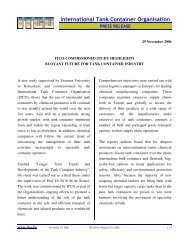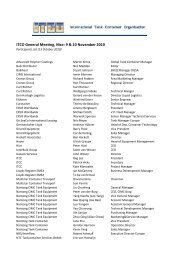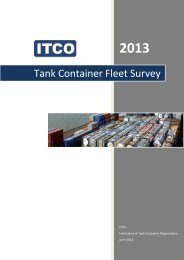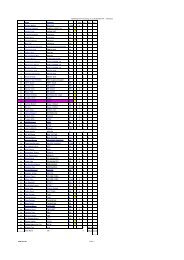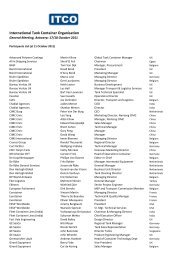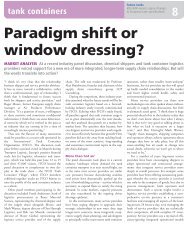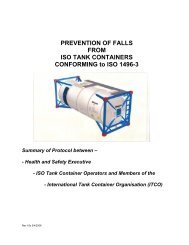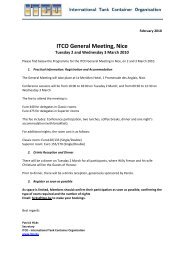Create successful ePaper yourself
Turn your PDF publications into a flip-book with our unique Google optimized e-Paper software.
ICHCA International <strong>Safe</strong>ty Panel Briefing Pamphlet No 30<br />
10.2.2 Arising from that assessment, the terminal should produce written<br />
procedures for receiving and identifying tank containers and how to handle<br />
them safely. Such procedures should include ensuring that container<br />
handlers are provided with all relevant information, instructions and training<br />
for handling the various types <strong>of</strong> containers.<br />
10.2.3 Training should be based upon the risk assessment and include alertness<br />
on the part <strong>of</strong> the drivers <strong>of</strong> lifting and carrying equipment in regard to the<br />
risks.<br />
10.2.4 All equipment used must be serviceable, having inspections and tests as<br />
required and must be suitable for the task.<br />
10.2.5 Empty tank containers that last contained dangerous goods and have not<br />
been cleaned must be declared as EMPTY UNCLEANED or RESIDUE<br />
LAST CONTAINED under the provisions <strong>of</strong> the IMDG Code.<br />
10.2.6 All empty tanks must be treated as still carrying the last cargo unless a valid<br />
cleaning certificate is available.<br />
10.3 <strong>Handling</strong> <strong>Tank</strong> <strong>Containers</strong> fitted with Compartments<br />
10.3.1 <strong>Tank</strong> containers built with two or more discrete compartments may present a<br />
number <strong>of</strong> loading and handling issues:<br />
The manways to each compartment may not be easily seen, or be<br />
obscured by the insulation and walkway, so container handlers may<br />
not be aware that the tank container has more than one compartment.<br />
Each compartment is capable <strong>of</strong> carrying a different cargo, each <strong>of</strong><br />
which may have a different mass which may affect the centre <strong>of</strong><br />
gravity <strong>of</strong> the tank container(see also Annex 2 section A2.1).<br />
Where the tank container is carrying more than one dangerous good<br />
then the shipper must ensure that each are compatible and may be<br />
carried in the same tank container (although in different<br />
compartments).<br />
10.3.2 When loading a tank container with two or more compartments, the shipper<br />
should ensure:<br />
that each compartment is filled in line with the filling requirements (see<br />
Annex 2 section A2.2) especially if the capacity <strong>of</strong> the compartment is<br />
greater than 7,500 litres.<br />
that the cargo is loaded so that the tank container is balanced;<br />
that where more than one dangerous good is being shipped, that each<br />
dangerous goods has all appropriate marks and / or placards at each<br />
end and on each side adjacent to the compartment carry the particular<br />
dangerous goods.<br />
10.3.3 Balance can be achieved by:<br />
loading an equal mass <strong>of</strong> each cargo into all the compartments so long<br />
as the filling requirements are maintained.<br />
counterbalancing a single cargo with water (in a two compartment tank<br />
container)<br />
loading a single cargo into the central compartment where there are<br />
three compartments<br />
Page 32 ©ICHCA International Limited



